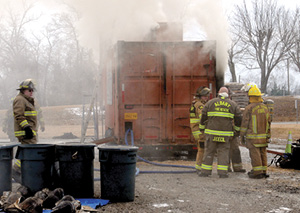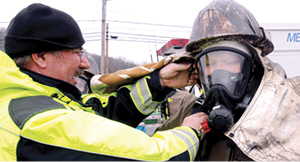Fire department training helps to keep firemen safer when the ‘call goes out’
Motorists passing by the Clinton County Board of Education offices last Saturday may have been alarmed at the rising smoke and high paced activity by the members of the Albany Fire Department on the property.
While there were fires, smoke and plenty of firemen on the scene, it was all a controlled training exercise designed not only to give the members of the local department more experience to better battle structure fires, but most importantly to provide training that will keep those fire fighting volunteers safer.
The Albany Fire Department took part in a training exercise Saturday morning to satisfy some training for newer members and continued education for firefighters who are already certified.
According to Fire Chief Robert Roeper, to become classified as a fire fighter, 150 hours of training is required and the exercise performed Saturday will count toward that goal.
The exercise was a controlled training event to prepare firefighters for a flash-over.
“If a house is burning and the fire spreads from one room to another the flames come on top of you,” Roeper said. “They build the fire up with pallets and hay and the trailer represents a house when it spreads from one room to another room. They (firemen in training) will have flames over the top of them. They have to stay in there and know how to control that.”
Roeper said it gives the experience needed when someone volunteers as a firefighter.
“It’s a really good controlled situation,” Roeper said. “To get state certified training, we have two years to get 150 hours and this is one of the criteria for getting certified.”
There are several new members at the Albany Fire Department and this training will help them on the road to getting certified.
“Within the last year we have about five new members,” Roeper said. “You have to keep fresh people who are able to go in, so we have to keep rotating in order to keep people who are able to do that kind of work.
Not only was the Albany Fire Department on hand for the training, but several other departments from surrounding areas also participated in the training exercise including firefighters from Suzie Fire Department, Eli Fire Department, Clementsville, KY, and Taylor County.
“Some of the instructors work out of Taylor County, but they brought some of their guys with them as well,” Roeper said.
Other than dealing with what’s inside the trailer, fire fighters have to deal with cooling down once they come out of the fire box.
“Once you come out you can’t just grab your helmet and take it off,” Roeper said. “If you try and take your helmet off you will fry your fingers. With this exercise, you are completely covered from head to toe. You are inspected prior to going in. The instructors will make sure you don’t have any skin showing anywhere in order to make sure everybody is going to come out in as good of shape as when they went in.”
In addition to the training on Saturday, the Albany Fire Department also used the training event to break in new suits that were issued this week.
“People don’t realize, but to put everything new on a firefighter it costs $7,500,” Roeper said. “You have to constantly apply for grants and you get a small percentage of what you apply for, but you have to keep doing it. We also use our photo sales to help with the cost, and the money taken out of the water bills goes toward that as well.”
During the exercise, there were six state fire instructors on hand.
One instructor on hand was Marty Kazsuk. Kazsuk is a 12 year veteran of the fire service, serving the last five years as a career firefighter/EMT with the Nicholasville Fire Department, where he holds the rank of lieutenant.
Kazsuk is also a member of the Eli Volunteer Fire and Rescue Department and serves as the deputy chief. He teaches part-time as a field instructor for State Fire and Rescue Training area 14. Headquarters for Area 14 is in Campbellsville, Ky.
“As far as your certification to be 150 hours certified, this meets the requirements for a category, which is three hours in flash-over recognition,” Kazsuk said. “If you are already 150 hours certified, you are required to have 20 hours of continuing education each year, so this will end up being a seven hour class toward that 20 hours.”
Even for the experienced firefighter, this exercise is very important for their training because it gives them more experience in a controlled setting.
“It teaches them flash-over recognition, so if they were to get into a structure fire and these signs were visible, they will know to either get out or extinguish the fire,” Kazsuk said. “When flash-over occurs, temperatures can get anywhere from 900 to 1,100 degrees and nobody can sustain that kind of heat. Fire gear is going to start failing at around 700 degrees.”

Above is a view from the outside at the smoke and fire coming from the trailer used during the flash-over exercise on Saturday

Above, Albany Fire Chief Robert Roeper helped fireman Junior Cecil with his head gear before Cecil entered the flash-over training trailer. The flash-over training benefits new members as well as providing continuing education for members who already have the required 150 training hours to be certified as a firefighter.



